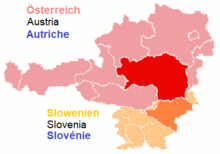Duchy of Styria
Duchy of Styria Herzogtum Steiermark ( Latin ) | |||||||||||
|---|---|---|---|---|---|---|---|---|---|---|---|
| 1180–1918 | |||||||||||
German Austria | 10 September 1919 | ||||||||||
| |||||||||||
| Today part of | Austria Slovenia | ||||||||||
* Transferred by inheritance on the extinction of the ducal line. † Transferred by conquest. | |||||||||||
The Duchy of Styria (German: Herzogtum Steiermark; Slovene: Vojvodina Štajerska; Hungarian: Stájer Hercegség) was a duchy located in modern-day southern Austria and northern Slovenia. It was a part of the Holy Roman Empire until its dissolution in 1806 and a Cisleithanian crown land of Austria-Hungary until its dissolution in 1918.
History
It was created by Emperor

The Austrian Babenbergs became extinct in 1246, when Duke
The
A second Inner Austrian cadet branch of the Habsburgs ruled over Styria from 1564. Under Archduke

Styria remained a part of the
On the collapse of Austria-Hungary in the aftermath of
Name
| History of Austria |
|---|
 |
|
|
Styria was attested in historical documents in AD 907 as Styria, in 1191 as Marchia Stirensis, and in 1215 as Marchia Styrie.[1] The name is of pre-Romance substrate origin. The German name Steiermark is a compound; the first element is borrowed from the ancient name Stiria and the second element, Mark, means 'march, border region'. The Slovene name Štajerska and the Czech name Štýrsko are borrowed and adapted from the German name for the region.[1]
Demographics
In 1910 the population of Styria included:[2]
Dukes
Various dynasties
- Ottokar IV (1180–1192), had been the Margrave of Styria since 1164.
- Leopold V of Austria (1192–1194)
- Leopold VI of Austria (1194–1230), son
- Frederick II of Austria (1230–1246), son, killed in battle
- Ottokar II of Bohemia (1251/1260–1278), against
- Béla IV of Hungary (1254–1258) and his son
- Stephen V of Hungary (1258–1260), claimants
House of Habsburg
- Rudolph I (1278–1282), also King of the Romans1273–1291
- Albert I (1282–1308), son, also King of the Romans from 1298, jointly with his brother
- Rudolph II (1282–1283) and his son
- Rudolph III(1298–1307)
- Frederick the Fair (1308–1330), son of Albert I, jointly with his brother
- Leopold I (1308–1326)
- Albert II (1330–1358), son of Albert I, jointly with his brother
- Otto the Merry (1330–1339)
- Rudolph IV (1358–1365), son of Albert II
- Albert III (1365–1379), son of Albert II, jointly with his brother
- Leopold III (1365–1386), Duke of Inner Austria from 1379
- William (1386–1406), son of Leopold III
- Ernest the Iron (1406–1424), son of Leopold III
- Frederick V (1424–1493), son of Ernest the Iron, also King of the Romans from 1440, Holy Roman Emperor from 1452 and Archduke of Austria from 1457, jointly with his brother
- Albert VI (1424–1463)
- Maximilian I (1493–1519), also Archduke of Austria, Holy Roman Emperor (Emperor-elect) from 1508
- Charles I (1519–1521), also Archduke of Austria, Holy Roman Emperor 1530-1556
- Ferdinand I (1521–1564), also Archduke of Austria, Holy Roman Emperor from 1558
- Charles II(1564–1590), Archduke of Inner Austria
- Ferdinand II (1590–1637), Archduke of Inner Austria, also Archduke of Austria and Holy Roman Emperor from 1619
See List of rulers of Austria.
See also
References
External links
- Map of the Balkans, 1815–59, showing the Duchy of Styria


